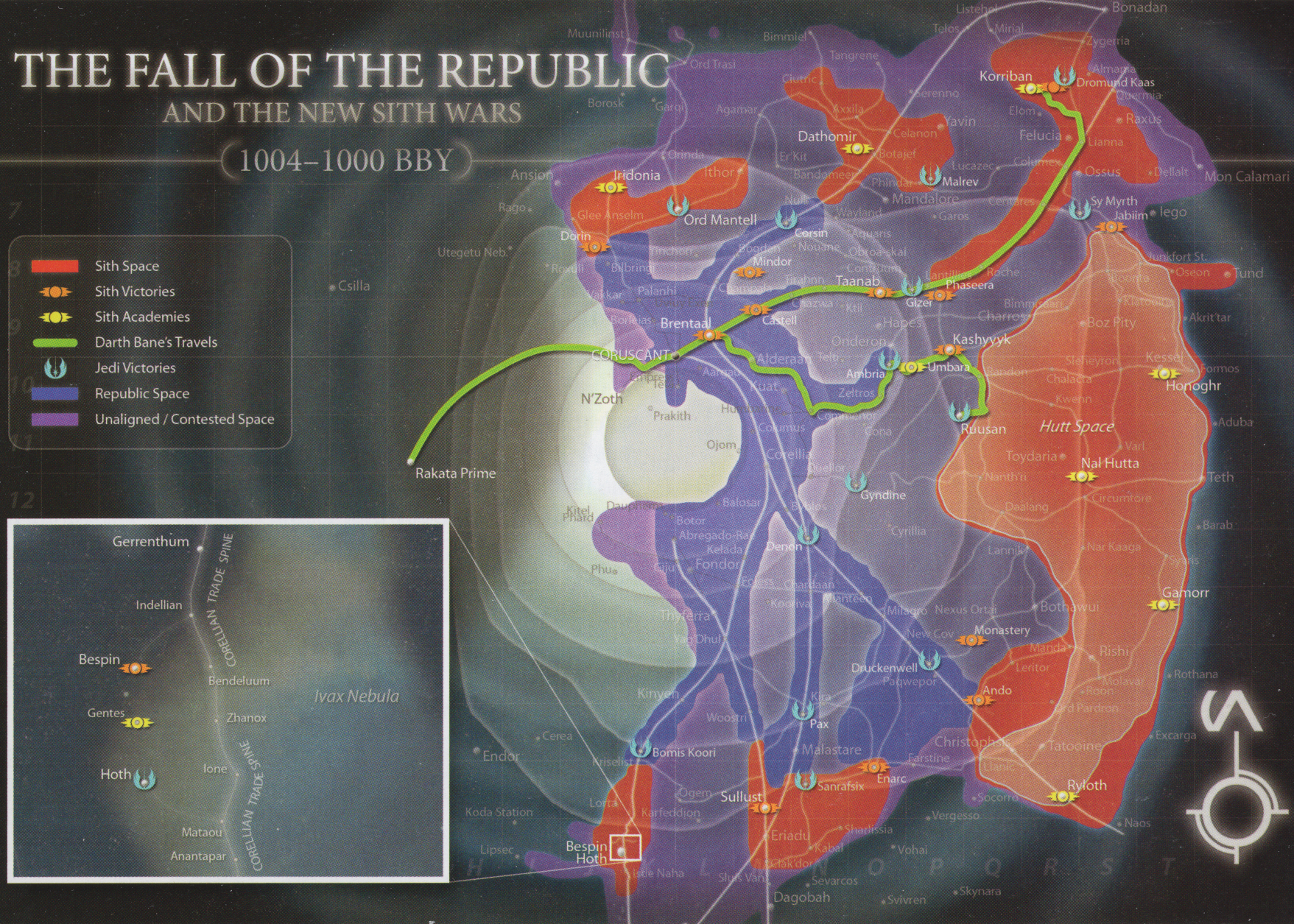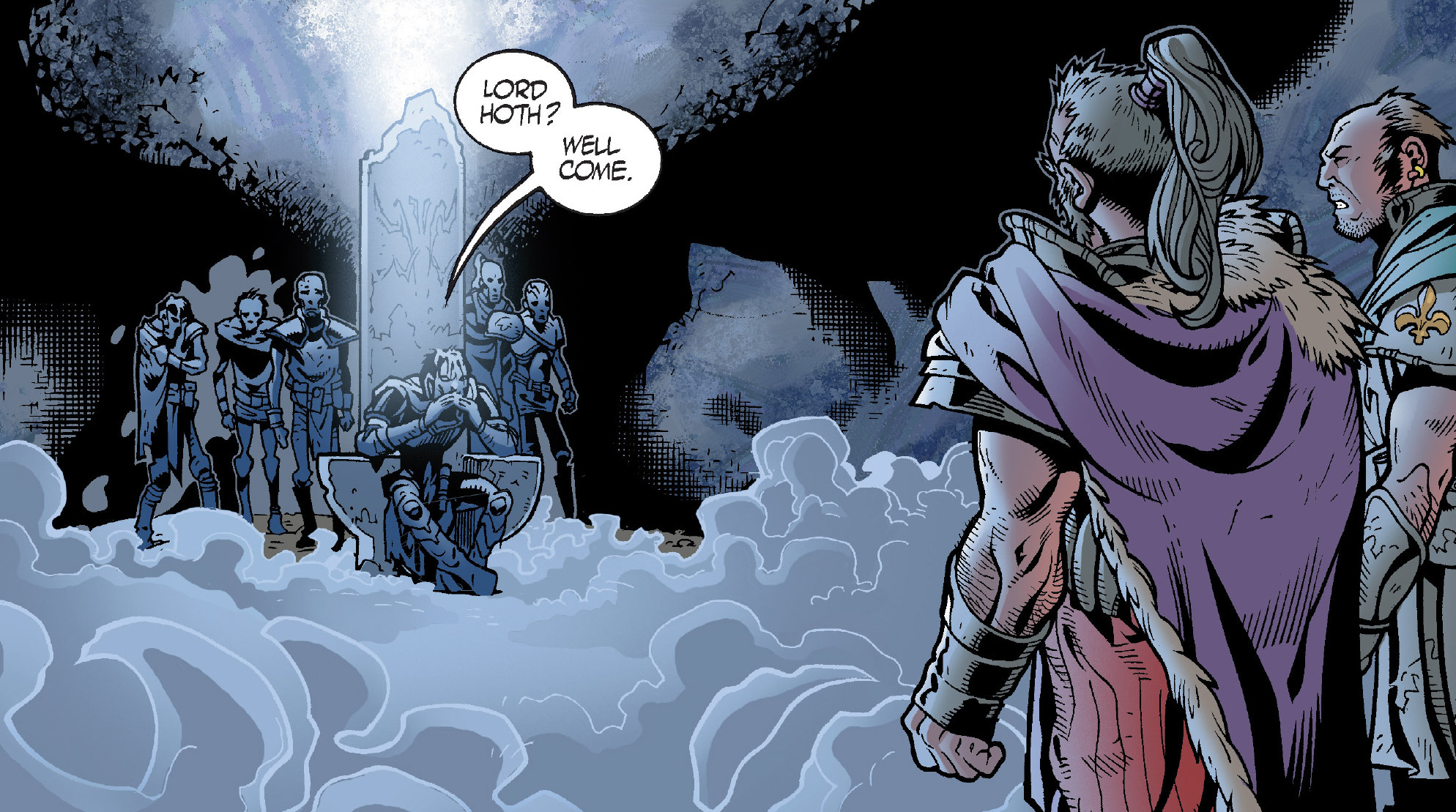Wary of the growing power and popularity of the Jedi Lords, the Jedi High Council attempted to groom their own champion against the Sith—Skere Kaan, born a commoner on Coruscant before being discovered by the Jedi Order and trained in the ways of the Force at the Jedi Temple. Sophisticated and knowledgeable of economic policy and fleet command, Kaan became a Jedi Knight and a beacon for hope among members of the Jedi High Council who hoped to finally destroy the reformed Sith Empire which had been plaguing the Galactic Republic for nearly two centuries.
Having perfected the art of battle meditation, Jedi Kaan was considered a valuable asset by the High Council, despite his radical belief that the Republic and the Jedi were responsible for the anarchy which plagued the galaxy. In an effort to moderate Kaan's extremist views, the High Council awarded him the title of Jedi Master. Seeing the High Council as overbearing, Kaan led a group of loyal Knights away from Coruscant and defected to the Sith.
Out of the ashes of the Sith Empire, Kaan reorganized the Sith into the Brotherhood of Darkness, over 20,000 strong. In an attempt to end the internecine feuds that had torn their Empire apart, Kaan ended the tradition of a sole Dark Lord of the Sith, and recognized each and every claim to the title by the rival warlords. Kaan forged his alliance with the creed of "Rule by the Strong" and "All are equal in the Brotherhood of Darkness." He made his headquarters on the planet Roon.
Beginning in around 1010 BBY, this new group launched a series of attacks designed to destroy the Jedi and the Republic. Kaan, along with the two strongest of the former warlords, Qordis and Kopecz, began their campaign with a daring and symbolic assault on the ancient Sith homeworld of Korriban, which at that time was still under nominal Republic control. The successful capture of that world sealed their alliance, and enabled the reopening of the ancient Sith academy under Qordis' leadership.
As Qordis trained new recruits, Kaan and Kopecz continued their war, seizing worlds like Kashyyyk, and even briefly Corulag, Chandrila and Brentaal IV. By 1001 BBY, they seemed almost poised to conquer Coruscant, pressing the Republic on many fronts with the assistance of allies such as the turncoat Jedi King Lahzar, who battled the Republic in the Tholatin system and a colony of Chiss on Thule, abducted from the Unknown Regions by agents of Kaan.
However, Lord Hoth, a Jedi Master and Republic General, had been scoring victories of his own against the Sith. Driving the Brotherhood from their home in the heavily-defended region of space known as the Cloak of the Sith, Hoth chased them from world to world, from Hoth to Dromund Kaas to Malrev IV. In many of his earlier campaigns, he commanded Republic fleets and armies, but around 1002 BBY, he forged the bulk of the Jedi Order's fighting strength into an independent military force known as the Army of Light.

A map of the latter stages of the Light and Darkness War, 1004 BBY, to 1000 BBY
The war ended with the armies of Hoth and Kaan facing each other on the world of Ruusan. Lord Hoth's army of was made of seven , each led by a Jedi Lord, including Valenthyne Farfalla, Gale, Saleeh Teepo, Berethon and Newar Forrth. Under the Jedi Lords served Jedi Generals such as Kiel Charny. Kaan's Brotherhood was led by himself, Qordis, Kopecz and less familiar Dark Lords such as Seviss Vaa, LaTor and Githany.
The Army of the Light and the Brotherhood of Darkness clashed seven times on the world, each battle causing terrible casualties as Sith and Jedi died in the thousands. Throughout the course of the battles, additional reinforcements attempted to land on Ruusan, though many Jedi forces were destroyed by an orbiting Sith blockade and many Sith reinforcements were destroyed by the Republic Navy en route to Ruusan.
Though four of the seven battles were won by the Army of Light, their casualties were still enormous and the campaign would later be considered to be the most deadly clash between Jedi and Sith in galactic history. So many Jedi died that Hoth was forced to enlist younger and younger Force-sensitive recruits, and Jedi scouts such as Torr Snapit began to bring pre-adolescents to the battlefield. Though Hoth and his advisors found this distasteful, they reluctantly agreed to accept the child recruits, reasoning that it was better for them to be found by the Jedi than by Kaan's Sith.
Dissension was rife in both camps - for the Jedi, Hoth feuded with his fellow Lord Valenthyne Farfalla, a rift which only deepened with the death of Pernicar, a Jedi Master who had mediated between the two Lords. Even when Farfalla arrived with over three hundred fresh knights as reinforcements, having both defeated the traitorous King Lahzar and broken the Sith blockade over Ruusan, Hoth still refused to speak to him.
The Jedi were further undermined when a new recruit, Darovit turned traitor, murdering General Charny and defecting to the Sith.
Among the Sith, Kaan's leadership began to be questioned by both Githany and Kopecz, and Kaan's bungled attempt to remove his rival Darth Bane only served to make him seem foolish, especially after Bane defeated Qordis, Kaan's strongest supporter. Bane mocked Kaan's reliance on traditional weapons of war, and goaded the Sith leader into using the dark side of the Force to destroy Hoth and the Jedi. With Bane's help, Kaan and the other Dark Lords devastated the unprepared Jedi with a Force Storm that ravaged Ruusan's surface.
Fortune began to favor the Jedi, though, and thanks to the timely intervention of Farfalla's envoy, and Hoth's own vision of the dead Pernicar, the two Jedi leaders reconciled, pooling their forces just in time to counteract a renewed Sith surge.
Finally, with both armies nearly destroyed, and the once lush planet totally devastated, the seventh and final Battle of Ruusan took place, ending with Kaan's decision to use an ancient Sith technique known as the thought bomb, the instructions secretly provided by Darth Bane in a plot to destroy the other Sith Lords and leave Bane to rebuild the Sith under the "Rule of Two." Lord Hoth, knowing of his opponent's final gambit, took 99 of his most trusted knights with him and confronted Kaan in an attempt to dissuade the Sith Lord from unleashing the weapon. His friend, Tal attempted to dissuade him, having seen disaster through the Force. Lord Farfalla did likewise, but Hoth told both that Kaan had to be stopped.

The confrontation between Lord Hoth and Lord Skere Kaan in the Valley of the Jedi
The attempt was fruitless, as Kaan's mind had broken during the conflict and the Sith Lord, insanity clouding his vision, was determined to destroy himself and his followers, hoping to annihilate the Army of the Light at the same time.
As Kaan unleashed his weapon, both his own army and Hoth's were destroyed in an instant. Those Jedi that survived quickly rallied under Lord Farfalla, and the remaining Sith were easily defeated. Darth Bane, in the meantime, went into hiding with his apprentice, Zannah.
After a thousand years, the New Sith Wars had finally come to an end.
With the apparent destruction of the Sith, Farfalla, as highest ranking surviving Jedi, used his authority to remove the Jedi from the position of galactic leadership they had acquired during the past centuries, and hand control back to civilian leadership. Tarsus Valorum became the first non-Jedi to serve as Chancellor for six hundred years and, with Farfalla's assistance, Valorum passed far-reaching legislation that restructured both the Republic and the Jedi Order.
- The Complete Star Wars Encyclopedia
- The Essential Guide to Warfare
- Star Wars: Edge of the Empire Core Rulebook
- Star Wars: Age of Rebellion Core Rulebook